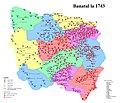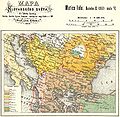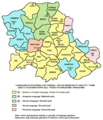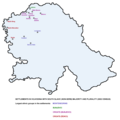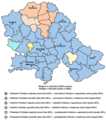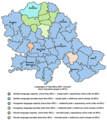Demographic history of Vojvodina
This article includes a list of general references, but it lacks sufficient corresponding inline citations. (November 2015) |
Vojvodina's demographic history reflects its rich history and its former location at the border of the Ottoman and Habsburg empires and at the confluence of various peoples, making it a hotbed of invasion, colonization, and assimilation processes. Currently there are more than 25 ethnic groups living in Vojvodina and six official languages.
Demographic history
This section focuses too much on specific examples. (November 2015) |
The area of Vojvodina had been inhabited since the Paleolithic period. Indo-European peoples moved into this area during three migration waves, which are dated in 4200 BC, 3300 BC, and 2800 BC respectively. Before the Roman conquest in the 1st century BC, Indo-European peoples of Illyrian, Thracian and Celtic origin inhabited the region.
During the Roman administration (which extended to Syrmia and Banat), original inhabitants were heavily Romanized, later to become known by the name of Vlachs. Region of Bačka, which did not belonged to the Roman Empire, was populated by Iranian Sarmatians (Iazyges). After the end of the Roman rule, the Romanized inhabitants of the area escaped to Balkanic mountains (where they mixed with South Slavs) as well as to the Transylvanian mountains (where they later were known as Romanians).[1]
Vojvodina was invaded by the Turanic nomads such as the Huns and Avars, as well as by the Germanic Goths, Gepids and Lombards, but after their military defeat, they were quickly absorbed by the local (Slavic) population, without leaving much ethnic traces in population of the region.
During the early medieval migrations, Slavs (Severans, Abodrites, Braničevci, Timočani and Serbs) settled today's Vojvodina in the 6th and 7th centuries.[2] According to some sources, pockets of Romanised population remained in the area.[citation needed] Until the Hungarian conquest in the 10th century, the region had dominant Slavic population.[3]
-
Indo-European peoples in Vojvodina in ancient times.
-
Slavs in Vojvodina in the 6th century.
-
Slavs in Vojvodina in the 6th–7th century.
-
Ethnic map of Vojvodina (6th–8th century).
-
Slavs in Vojvodina in the 7th–8th century.
-
Slavs in Vojvodina in the 9th century, before the Hungarian conquest.
The region was conquered by the Principality of Hungary (later Kingdom of Hungary) in the 10th century, and Hungarians started to settle in the area. Hungarians mainly settled in northern part of the region, where they lived mixed with Slavs. Until the late 12th and early 13th century, the region was mainly populated by Slavs, after which the ethnic relations changed in favor of Hungarians. The larger number of Hungarians settled in the region since the 13th century. The presence of Slavs in the area increased again in the 14th century with the arrival of many Serbs from the south. During the Hungarian administration, much of the native local Slavs were Hungarized.[4] Initially, the Hungarian language was spoken only by the knights and nobility of the Kingdom of Hungary, but it was later adopted also by the rest of the population.[5] By the opinion of some researchers, the non-Hungarized descendants of these local Slavs are present-day Šokci.[6]
Though Serbs were part of the aboriginal Slavic population in the territory of Vojvodina (especially in Syrmia), an increasing number of Serbs began settling from the 14th century onward. Because of the presence of the large Serb population, in many historical records and maps, which were written and drawn between 15th and 18th centuries, territory of present-day Vojvodina was named Rascia (Raška, Serbia) and Little Raška (Little Serbia). See also Rascians.
The Ottoman Empire took control of Vojvodina in the 16th century, and this caused a massive depopulation of the region. Most of the Hungarians and many local Slavs fled from the region and escaped to the north. The majority of those who left in the region were Serbs, mainly now engaging either in farming either in Ottoman military service.
Under Ottoman policy, many Serbs were newly settled in the region. During the Ottoman administration, Serbs comprised an absolute majority of population of Vojvodina.[7] In that time, villages were populated exclusively by Serbs, while cities were populated by various ethnic and religious groups, including mainly Muslims and Serbs, but also some Cincars, Greeks, Jews and Roma.[8]
The Habsburg Monarchy took control of Vojvodina among other lands by the treaties of Karlovci (1699) and Požarevac (1718). Following the establishment of the Habsburg administration, the Muslim population fled from the region. Some of these Muslim refugees were resettled in Bosnia and Herzegovina. During the Habsburg administration, many new Serb settlers from the Ottoman Empire immigrated to the region. In 1687, the northern parts of the region were settled by ethnic Bunjevci.
Many other non-Serb settlers were also settled in the territory of present-day Vojvodina during the 18th and 19th century. They were mainly Germans and Hungarians, but also Rusyns, Slovaks, Romanians, and others. Because of this settling, Serbs lost the absolute ethnic majority in the region, and Vojvodina became one of the most ethnically diverse regions of Europe.
Still, Serbs remained the largest ethnic group in the region. According to 1910 census, Serbs comprised 33.8% of the population in the territory of present-day Vojvodina. After Serbs, the most numerous ethnic groups were Hungarians (28.1%) and Germans (21.4%).
In 1918, Vojvodina became part of the Kingdom of Serbs, Croats and Slovenes and new Serb settlers came to the region. As the consequence of the Second World War events, most of Vojvodina Germans (about 200,000) left from Vojvodina together with defeated German army.[9] Those who remained in the region were sent to local communist prison camps. After prison camps were dissolved (in 1948) and Yugoslav citizenship was returned to the Germans, the remaining German population left Yugoslavia because of economic reasons.[10] Instead of them, new South Slavic (Serb, Montenegrin, Macedonian, Croat, etc.) colonists settled in the region. According to the 1948 census, Serbs were absolute majority in Vojvodina again (51%), and this percent rose to 65% in 2002 census. The multiethnic character of the region is also preserved.
-
Ethno-religious situation in some main cities of Vojvodina during Ottoman administration (16th–17th century)
-
Territory with South Slavic majority between 16th and 18th century (according to Jovan Cvijić and Dušan J. Popović)
-
Ethnic map of Bačka (1715 census)
-
Ethnic map of Bačka (1720 census)
-
Ethnic map of Banat in 1743
-
Ethnic map of Banat in 1774
Population data from the Hungarian administration period
9th century
When Hungarians arrived to Central Europe (in 896), this region was populated exclusively by Slavs.[11]
15th century
In the 15th century, according to opinion of various researchers, South Slavic (Serbian and Croatian) population was dominant in Syrmia and southern Banat, while Hungarian population was dominant in Bačka and northern Banat. According to Hungarian author Károly Kocsis, 194,000 inhabitants might have been living on the present-day territory of Vojvodina in 1495.[12] That number was calculated on the basis of work of Kubinyi, A. (1966), who processed the data of the tax inventory conducted in 1495 by Sigismund Ernust, Chancellor of the Royal Treasury. Some 52 townships (civitas, oppidium) and 801 villages could be found in the area, in which, according to Kocsis, Hungarians are likely to have constituted the majority of population. According to this view, the population of the area included 148,000 (76,1%) Hungarians, 39,000 (20%) Serbs and 7,500 (3,9%) Croats.[13][14] However, calculation of demographic data from this time period can be described as vague and of a rather varied nature,[15] due to the lack of censuses that would collect comprehensive ethnic information. For the time of the Hungarian royal tax registration in 1495, conclusions for a probable absolute or relative „ethnic" majority of the population living in the area were drawn from the given sources through analysing direct references of „ethnic nature", in most cases by the linguistic analysis of taxpayers' names and that of geographical names.[16]
Population data from the Ottoman administration period
During Ottoman administration (16th–18th century), the region of Vojvodina had an absolute Serb majority.[17]
Population data from the Habsburg administration period
1690
In 1690, about 210,000 Serbs lived in Vojvodina (excluding Srem).[18] In this time, almost entire population of the region was composed of Serbs, also including some Šokci.[19]
1715
According to the Austrian census in Bačka from 1715, Serbs, Bunjevci, and Šokci comprised 97.6% of population.[20]
1718–1720
The 1720 census in Bačka recorded 72% Serbs and 22% Bunjevci and Šokci.[21] After the Treaty of Passarowitz (1718), the first Habsburg census recorded in Banat about 20,000 citizens, mostly Serbs.[22]
1787
| Number | % | |
| TOTAL | 476,018 | 100.0 |
| Serbs | 281,690 | 59.2 |
| Germans | 58,866 | 12.4 |
| Hungarians | 50,316 | 10.6 |
| Croats | 38,161 | 8.0 |
| Romanians | 27,436 | 5.8 |
| Slovaks | 9,704 | 2.0 |
| Rusyns | 3,836 | 0.8 |
| Romani | 1,600 | |
| Bulgarians | 400 |
1828
| Number | % | |
| TOTAL | 864,281 | 100.0 |
| Serbs | 442,923 | 51.1 |
| Germans | 142,653 | 16.4 |
| Hungarians | 130,918 | 15.1 |
| Croats | 67,692 | 7.8 |
| Romanians | 46,645 | 5.4 |
| Slovaks | 19,464 | 2.2 |
| Rusyns | 6,068 | 0.7 |
| Romani | 1,700 | |
| Bulgarians | 1,264 |
1840
| Number | % | |
| TOTAL | 912,754 | 100.0 |
| Serbs | 448,341 | 49.1 |
| Germans | 154,047 | 16.9 |
| Hungarians | 145,930 | 16.0 |
| Croats | 66,362 | 7.3 |
| Romanians | 55,984 | 6.1 |
| Slovaks | 22,924 | 2.5 |
| Rusyns | 7,373 | 0.8 |
| Romani | 1,900 | |
| Bulgarians | 686 |
1857
| Number | % | |
| TOTAL | 1,030,545 | 100.0 |
| Serbs | 417,838 | 40.5 |
| Germans | 217,510 | 21.1 |
| Hungarians | 202,188 | 19.6 |
| Romanians | 65,387 | 6.3 |
| Croats | 60,690 | 5.9 |
| Slovaks | 35,328 | 3.4 |
| Rusyns | 8,452 | 0.8 |
| Bulgarians | 2,160 | |
| Romani | 1,297 |
1880 census
| Number | % | |
| TOTAL | 1,172,729 | 100.0 |
| Serbs | 416,116 | 35.5 |
| Germans | 285,920 | 24.4 |
| Hungarians | 265,287 | 22.6 |
| Croats, Bunjevci & Šokci | 72,486 | 6.2 |
| Romanians | 69,668 | 5.9 |
| Slovaks | 43,318 | 3.7 |
| Rusyns & Ukrainians | 9,299 | 0.8 |
| Others | 10,635 | 0.9 |
-
Linguistic structure of Vojvodina by settlements 1880–1884 (present territorial organization)
-
Religious structure of Vojvodina by settlements 1880–1884 (present territorial organization)
1890 census
| Number | % | |
| TOTAL | 1,331,143 | 100.0 |
| Serbs | 457,873 | 34.4 |
| Hungarians | 324,430 | 24.4 |
| Germans | 321,563 | 24.2 |
| Croats, Bunjevci & Šokci | 80,404 | 6.0 |
| Romanians | 73,492 | 5.5 |
| Slovaks | 49,834 | 3.7 |
| Rusyns & Ukrainians | 11,022 | 0.8 |
| Others | 12,525 | 1.0 |
-
Ethnic map of Vojvodina in 1867
-
Ethnic map of Vojvodina in 1868
-
Ethnic map of Vojvodina in 1876
-
Ethnic map of Vojvodina in 1880
-
Ethnic map of Vojvodina in 1892
-
Slavs in Vojvodina in 1900
1900 census
| Number | % | |
| TOTAL | 1,432,748 | 100.0 |
| Serbs | 483,176 | 33.7 |
| Hungarians | 378,634 | 26.4 |
| Germans | 336,430 | 23.5 |
| Croats, Bunjevci & Šokci | 80,901 | 5.6 |
| Romanians | 74,718 | 5.2 |
| Slovaks | 53,832 | 3.8 |
| Rusyns & Ukrainians | 12,663 | 0.9 |
| Others | 12,394 | 0.9 |
1910 census
| Number | % | |
| TOTAL | 1,512,983 | 100.0 |
| Serbs | 510,186 | 33.8 |
| Hungarians | 424,555 | 28.1 |
| Germans | 323,779 | 21.4 |
| Romanians | 75,223 | 5.0 |
| Slovaks | 56,689 | 3.7 |
| Croats | 34,089 | 2.3 |
| Rusyns | 13,479 | 0.9 |
| Others | 72,804 | 4.8 |
Note that linguistic data from this census might not correspond with ethnic structure in some settlements (Novi Sad, Subotica, Zrenjanin, etc.), due to the fact that Hungarian language was spoken by several ethnicities (Hungarians, Jews, Bunjevci, etc.).
-
Linguistic structure of Vojvodina by settlements 1910. (present territorial organization)
-
Religious structure of Vojvodina by settlements 1910. (present territorial organization)
-
Linguistic structure of Vojvodina by settlements 1910.
-
Linguistic structure of Vojvodina by municipalities 1910. (present territorial organization)
-
Linguistic map of Vojvodina in 1910
-
Linguistic map of Vojvodina in 1911
-
Ethnic map of Vojvodina in 1914
-
Ethnic map of Vojvodina in 1917
-
Ethnic map of Vojvodina in 1918, according to the Serbian geographer Jovan Cvijić
Population data from the Yugoslav and Serbian administration period
1921 census
| Number | % | |
| TOTAL | 1,528,238 | 100.0 |
| Serbs | 526,134 | 34.7 |
| Hungarians | 370,040 | 24.4 |
| Germans | 333,272 | 22.0 |
| Croats | 122,684 | 8.1 |
| Romanians | 65,197 | 4.3 |
| Slovaks | 58,273 | 3.8 |
| Rusyns | 13,664 | 0.9 |
| Others | 25,182 | 1.7 |
-
Language map of Vojvodina (1921 census)
1931 census
| Number | % | |
| TOTAL | 1,624,158 | 100 |
| Serbs | 528,000 | 33 |
| Hungarians | 413,000 | 26 |
| Germans | 343,000 | 21 |
| Croats | 120,000 | 7 |
| Romanians | 78,000 | 5 |
| Slovaks & Czechs | 67,000 | 4 |
| Rusyns | 21,000 | 1 |
| Jews | 21,000 | 1 |
| Others | 37,000 | 2 |
-
Language map of Vojvodina (1931 census)
1941 census
Note: 1941 census data for Bačka was combined with 1931 census data for Banat and Srem.
| Number | % | |
| TOTAL | 1,636,367 | 100.0 |
| Serbs | 577,067 | 35.3 |
| Hungarians | 465,920 | 28.5 |
| Germans | 318,259 | 19.4 |
| Croats | 105,810 | 6.5 |
| Others | 169,311 | 10.3 |
1948 census
| Number | % | |
| TOTAL | 1,663,212 | 100.0 |
| Serbs | 841,246 | 50.6 |
| Hungarians | 428,932 | 25.8 |
| Croats | 134,232 | 8.1 |
| Slovaks | 72,032 | 4.3 |
| Romanians | 59,263 | 3.6 |
| Germans | 31,821 | 1.9 |
| Montenegrins | 30,589 | 1.9 |
| Rusyns and Ukrainians | 22,083 | 1.3 |
| Macedonians | 9,090 | 0.5 |
| Romani | 7,585 | 0.4 |
| Slovenes | 7,223 | 0.4 |
| Russians | 5,148 | 0.3 |
| Czechs | 3,976 | 0.3 |
| Bulgarians | 3,501 | 0.2 |
| ethnic Yugoslavs | 1,050 | 0.1 |
| Others | 5,441 | 0.3 |
1953 census
| Number | % | |
| TOTAL | 1,699,545 | 100.0 |
| Serbs | 865,538 | 50.9 |
| Hungarians | 435,179 | 25.6 |
| Croats | 127,027 | 7.5 |
| Slovaks | 71,153 | 4.2 |
| Romanians | 57,218 | 3.4 |
| Montenegrins | 30,516 | 1.8 |
| Rusyns | 23,038 | 1.4 |
| Macedonians | 11,622 | 0.7 |
| Others | 78,254 | 4.6 |
-
Ethnic structure of Vojvodina by municipalities 1953.
1961 census
| Number | % | |
| TOTAL | 1,854,965 | 100.0 |
| Serbs | 1,017,713 | 54.9 |
| Hungarians | 442,560 | 23.9 |
| Croats | 145,341 | 7.8 |
| Slovaks | 73,830 | 4.0 |
| Romanians | 57,259 | 3.1 |
| Montenegrins | 34,782 | 1.9 |
| Rusyns | 23,038 | 1.4 |
| Macedonians | 11,622 | 0.7 |
| Others | 83,480 | 4.4 |
-
Ethnic structure of Vojvodina by settlements 1961.
-
Share of Serbs in Vojvodina by settlements 1961.
-
Share of Hungarians in Vojvodina by settlements 1961.
-
Share of Croats in Vojvodina by settlements 1961.
1971 census
| Number | % | |
| TOTAL | 1,952,533 | 100.0 |
| Serbs | 1,089,132 | 55.8 |
| Hungarians | 423,866 | 21.7 |
| Croats | 138,561 | 7.1 |
| Slovaks | 72,795 | 3.7 |
| Romanians | 52,987 | 2.7 |
| Montenegrins | 36,416 | 1.9 |
| Rusyns | 20,109 | 1.0 |
| Macedonians | 16,527 | 0.8 |
| Germans | 7,243 | 0.4 |
| Others | 94,897 | 4.9 |
-
Ethnic structure of Vojvodina by settlements 1971.
1981 census
| Number | % | |
| TOTAL | 2,034,772 | 100.0 |
| Serbs | 1,107,375 | 54.4 |
| Hungarians | 385,356 | 18.9 |
| Croats | 119,157 | 5.9 |
| Slovaks | 69,549 | 3.4 |
| Romanians | 47,289 | 2.3 |
| Montenegrins | 43,304 | 2.1 |
| Rusyns & Ukrainians | 24,306 | 1.2 |
| Germans | 3,808 | 0.2 |
| Others | 234,628 | 11.6 |
-
Ethnic structure of Vojvodina by settlements 1981.
-
Share of Montenegrins in Vojvodina by settlements 1981.
1991 census
| Number | % | |
| TOTAL | 2,012,517 | 100.0 |
| Serbs | 1,151,353 | 57.2 |
| Hungarians | 340,946 | 16.9 |
| ethnic Yugoslavs | 168,859 | 8.4 |
| Croats | 74,226 | 3.7 |
| Slovaks | 63,941 | 3.2 |
| Montenegrins | 44,721 | 2.2 |
| Romanians | 38,832 | 1.9 |
| Romani | 24,895 | 1.2 |
| Bunjevci | 21,552 | 1.1 |
| Rusyns | 17,889 | 0.9 |
| Macedonians | 16,641 | 0.8 |
| ethnic Muslims | 6,079 | 0.3 |
| Albanians | 2,959 | 0.2 |
| Slovenes | 2,563 | 0.1 |
| Ukrainians | 2,057 | 0.1 |
| Šokci | 1,866 | 0.1 |
| Others | 33,140 | 1.7 |
-
Ethnic structure of Vojvodina by settlements 1991.
-
Religious structure of Vojvodina by settlements 1991.
-
Share of Orthodox in Vojvodina by settlements 1991.
-
Share of Catholics in Vojvodina by settlements 1991.
-
Share of Protestants in Vojvodina by settlements 1991.
2002 census
| Number | % | |
| TOTAL | 2,031,992 | 100.00 |
| Serbs | 1,321,807 | 65.05 |
| Hungarians | 290,207 | 14.28 |
| Slovaks | 56,637 | 2.79 |
| Croats | 56,546 | 2.78 |
| ethnic Yugoslavs | 49,881 | 2.45 |
| Montenegrins | 35,513 | 1.75 |
| Romanians | 30,419 | 1.50 |
| Romani | 29,057 | 1.43 |
| Bunjevci | 19,766 | 0.97 |
| Rusyns | 15,626 | 0.77 |
| Macedonians | 11,785 | 0.58 |
| Ukrainians | 4,635 | 0.23 |
| ethnic Muslims | 3,634 | 0.18 |
| Germans | 3,154 | 0.16 |
| Slovenes | 2,005 | 0.10 |
| Albanians | 1,695 | 0.08 |
| Bulgarians | 1,658 | 0.08 |
| Czechs | 1,648 | 0.08 |
| Russians | 940 | 0.05 |
| Gorani | 606 | 0.03 |
| Bosniaks | 417 | 0.02 |
| Vlachs | 101 | 0.00 |
| Others | 5,311 | 0.26 |
| Regional identity | 10,154 | 0.50 |
| Undeclared | 55,016 | 2.71 |
| Unknown | 23,774 | 1.17 |
-
Ethnic structure of Vojvodina by settlements 2002.
-
Ethnic structure of Vojvodina by settlements 2002.
-
Ethnic structure of Vojvodina by settlements 2002.
-
Share of Serbs in Vojvodina by settlements 2002.
-
Share of Hungarians in Vojvodina by settlements 2002.
-
Share of Slovaks in Vojvodina by settlements 2002.
-
Share of Romanians in Vojvodina by settlements 2002.
-
Slovaks, Rusyns and Czechs in Vojvodina 2002.
-
Montenegrins, Bunjevci and Croats in Vojvodina 2002.
-
Ethnic structure of Vojvodina by municipalities 2002.
-
Share of Serbs in Vojvodina by municipalities 2002.
-
Share of Hungarians in Vojvodina by municipalities 2002.
-
Linguistic structure of Vojvodina by municipalities 2002.
-
Religious structure of Vojvodina by municipalities 2002.
2011 census
| Number | % | |
| TOTAL | 1,931,809 | 100.00 |
| Serbs | 1,289,635 | 66.76 |
| Hungarians | 251,136 | 13.00 |
| Slovaks | 50,321 | 2.60 |
| Croats | 47,033 | 2.43 |
| Romani | 42,391 | 2.19 |
| Romanians | 25,410 | 1.32 |
| Montenegrins | 22,141 | 1.15 |
| Bunjevci | 16,469 | 0.85 |
| Rusyns | 13,928 | 0.72 |
| Macedonians | 10,392 | 0.54 |
| Ukrainians | 4,202 | 0.22 |
| ethnic Muslims | 3,360 | 0.17 |
| Germans | 3,272 | 0.17 |
| Albanians | 2,251 | 0.12 |
| Slovenes | 1,815 | 0.09 |
| Bulgarians | 1,489 | 0.08 |
| Gorani | 1,179 | 0.06 |
| Russians | 1,173 | 0.06 |
| Bosniaks | 780 | 0.04 |
| Vlachs | 170 | 0.01 |
| ethnic Yugoslavs | 12,176 | 0.63 |
| Others | 6,710 | 0.35 |
| Regional identity | 28,567 | 1.48 |
| Undeclared | 81,018 | 4.19 |
| Unknown | 14,791 | 0.77 |
-
Ethnic structure of Vojvodina by municipalities 2011.
-
Ethnic structure of Vojvodina by municipalities in 2011.
-
Share of Serbs in Vojvodina by municipalities 2011.
-
Share of Hungarians in Vojvodina by municipalities 2011.
-
Religious structure of Vojvodina by municipalities 2011.
-
Religious structure of Vojvodina by municipalities in 2011.
-
Linguistic structure of Vojvodina by municipalities 2011.
-
Linguistic structure of Vojvodina by municipalities in 2011.
Future demographic trends
The general demographic trend in Vojvodina is a natural decrease in population. According to the 2011 census, the average age of the population of the province was 41.8. Ever since 1989, Vojvodina recorded negative natural growth, including all the ethnic groups. Despite that, number of ethnic Serbs in the province is increasing due to the constant immigration of Serbs from other parts of Serbia as well as Serbs from Republika Srpska and parts of Croatia neighboring Serbia. It is expected that by 2021 census, Serbs become relative majority in Bečej and Čoka municipalities as well as in the city of Subotica itself.
See also
- Ethnic groups of Vojvodina
- Demographic history of Bačka
- Demographic history of Serbian Banat
- Demographic history of Syrmia
- Demographic history of Novi Sad
- Demographic history of Subotica
References
- ^ Trajan Stojanović, Balkanska civilizacija, Beograd, 1995, page 103.
- ^ Dr. Drago Njegovan, Prisajedinjenje Vojvodine Srbiji, Novi Sad, 2004.
- ^ Dr Jovan Radonić, Srbija i Ugarska u srednjem veku, zbornik Vojvodina, knjiga I, PROMETEJ, Novi Sad, 2008, page 129.
- ^ Piotr Eberhardt, Ethnic groups and population changes in twentieth-century Central-Eastern Europe: history, data, and analysis, M.E. Sharpe, 2003, page 266.
- ^ Piotr Eberhardt, Ethnic groups and population changes in twentieth-century Central-Eastern Europe: history, data, and analysis, M.E. Sharpe, 2003, page 266.
- ^ Mile Nedeljković, Leksikon naroda sveta, Beograd, 2001.
- ^ Károly Kocsis, Eszter Kocsisné Hodosi, Ethnic Geography of the Hungarian Minorities in the Carpathian Basin, Simon Publications LLC, 1998, page 155.
- ^ Dr Dušan J. Popović, Srbi u Vojvodini, knjiga I, Novi Sad, 1990, page 212.
- ^ Dragomir Jankov, Vojvodina – propadanje jednog regiona, Novi Sad, 2004, page 76.
- ^ Nenad Stefanović, Jedan svet na Dunavu, Beograd, 2003, pages 174–176.
- ^ Dr Jovan Radonić, Srbija i Ugarska u srednjem veku, zbornik Vojvodina, knjiga I, PROMETEJ, Novi Sad, 2008, page 129.
- ^ http://www.mtafki.hu/konyvtar/kiadv/etnika/ethnicMAP/005_session_e.html
- ^ Hajnalka Bánszki: Népösszeírások, népszámlálások és statisztikák (censuses and statistics), History of censuses in Hungary
- ^ Károly Kocsis (DSc, University of Miskolc) – Zsolt Bottlik (PhD, Budapest University) – Patrik Tátrai: Etnikai térfolyamatok a Kárpát-medence határon túli régióiban, Magyar Tudományos Akadémia (Hungarian Academy of Sciences) – Földrajtudományi Kutatóintézet (Academy of Geographical Studies); Budapest; 2006.; ISBN 963-9545-10-4, CD Atlas
- ^ http://www.mtafki.hu/konyvtar/kiadv/etnika/ethnicMAP/005_session_e.html
- ^ http://www.mtafki.hu/konyvtar/kiadv/etnika/ethnicMAP/005_session_e.html
- ^ Károly Kocsis, Eszter Kocsisné Hodosi, Ethnic Geography of the Hungarian Minorities in the Carpathian Basin, Simon Publications LLC, 1998, page 155.
- ^ Dr Dušan J. Popović, Srbi u Vojvodini, knjiga 2, Novi Sad, 1990, page 26.
- ^ Dr Dušan J. Popović, Srbi u Vojvodini, knjiga 2, Novi Sad, 1990, page 27.
- ^ http://hic.hr/books/seeurope/011e-bognar.htm
- ^ Jovan Pejin, Velikomađarski kapric, Zrenjanin, 2007, page 28.
- ^ Milan Tutorov, Banatska rapsodija, Novi Sad, 2001, page 261.
- ^ Попис становништва, домаћинстава и станова 2011. у Републици Србији / 2011 Census of Population, Households and Dwellings in the Republic of Serbia, Belgrade, 2012
Sources
- Popović, Dušan J. (1957). Srbi u Vojvodini (1): Od najstarijih vremena do Karlovačkog mira 1699. Matica srpska.
- Popović, Dušan J. (1959). Srbi u Vojvodini (2): Od Karlovačkog mira 1699 do Temišvarskog sabora. Matica srpska.
- Popović, Dušan J. (1963). Srbi u Vojvodini (3): Od Temišvarskog sabora do Blagoveštenskog sabora 1861. Matica srpska.
- Branislav Bukurov; Bačka, Banat i Srem; Novi Sad; 1978.
- Milan Tutorov; Banatska rapsodija – istorika Zrenjanina i Banata; Novi Sad; 2001.
- Borislav Jankulov; Pregled kolonizacije Vojvodine u XVIII i XIX veku; Novi Sad – Pančevo; 2003.
- Károly Kocsis (DSc, University of Miskolc) – Zsolt Bottlik (PhD, Budapest University) – Patrik Tátrai: Etnikai térfolyamatok a Kárpát-medence határon túli régióiban + CD (for detailed data), Magyar Tudományos Akadémia (Hungarian Academy of Sciences) – Földrajtudományi Kutatóintézet (Academy of Geographical Studies); Budapest; 2006.; ISBN 963-9545-10-4 (data for 1495–1857)
Further reading
- Bosić, Mila (1990). "DOSELJAVANJE SRBA U VOJVODINU DO KRAJA XIX VEKA I NJIHOV OBIČAJNI ŽIVOT" (PDF). Etnološke sveske. 11: 43–53.
- Kostić, Lazo M. (1999). Srpska Vojvodina i njene manjine: demografsko-etnografska studija. Dobrica knjiga.
- Vlahović, Petar (1977). "Миграциони процеси и етничка структура Војводине". Гласник Етнографског музеја. 41.











